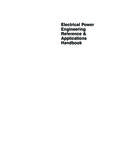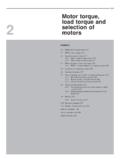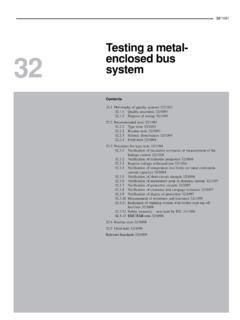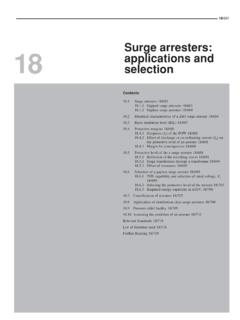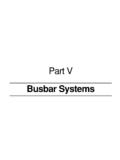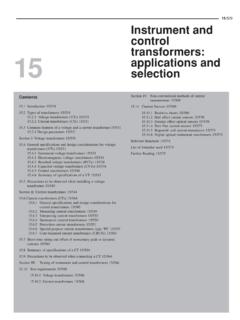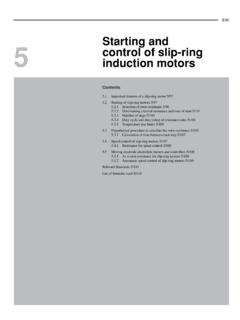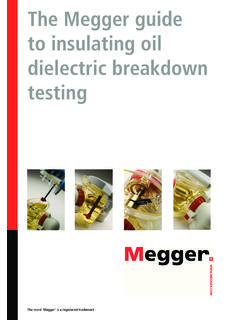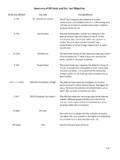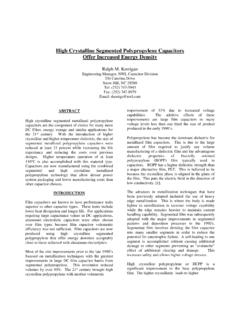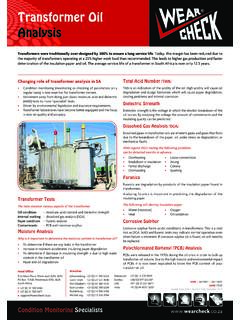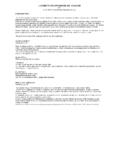Transcription of Winding insulation and maintenance
1 Materials and their properties 9 class A 9 class E 9 class B 9 class F 9 class H 9 of insulation 9 of insulation systems 9 motors 9 motors 9 for vacuum pressure impregnation 9 of insulation 9 insulation failure 9 of the insulation level 9 of the insulation level in large machines (1000 kW andabove) 9 the quality of insulation of MV formed coils and resin-poorwindings during manufacturing 9 of dielectric loss factor or dissipation factor (tan d) 9 test of resin-poor windings 9/264 Relevant Standards 9/265 List of formulae used 9/265 Further Reading 9/2659 Windinginsulation andmaintenance9/255 Winding insulation and maintenance9 insulating materials and theirpropertiesThe insulating materials form the heart of an electricalmachine. During operation these materials may be subjectto electrical, thermal and mechanical stresses andmust be capable to endure the same and possess thefollowing,Electrical stresses high breakdown voltage good long time performance low partial discharges (minimum voids withininsulation or on interface between insulation systems) very small leakage or creepage stresses high long time performance small deformation after temperature cycles least delamination within insulation materialMechanical stresses high mechanical strength to sustain forces due tohandling and mechanical forces under operation.
2 Least reduction of mechanical strength within specifiedoperating temperature and achieve the above one may improvise the impregnationprocess to minimize voids within insulating improvise hot iron press to minimize minute voidscreated inadvertently due to the process followed to wrapthe insulating tapes in many layers on the are some insulating and binding materialsthat have traversed since time immemorial and maycontinue in times ahead, wood, gutta-percha, textile and mica as insulatingmaterials. shellac or bitumen as binding material synthetic resigns like polyester and epoxy resin. silicon rubber as high temperature common types of insulating materials in use forelectric motors are E and B for small motors and F formedium sized and large ones. General industrial practice,however, is to limit the temperature to class B limits,even if class F insulation is class A, previously in use, has beendiscontinued in view of its low working frames have also been standardized with class Einsulation only by IEC recommendations, as in , to harmonize the interchangeability of electric decision was taken because class E insulation offersa higher working temperature and a longer working frames also ensure optimum utilization of activematerials such as copper and steel in a particular framesize.
3 The classification of insulating materials is basedon their maximum continuous working temperature,established for 20 years of working life. The recommendedtemperature according to IEC 60034-1 is, however, lessthan this, as shown in Table , to ensure an even longerlife. Where the ambient temperature is likely to be high,of the order of 60 C or so during operation, such as closeto a furnace, class F and H insulations are normally used,as they have higher working temperatures and brief description of the insulating materials in usefor different classes of insulation is given below to providean introduction to the types of materials being used inthe preparation of a particular class of insulation . Theactual ingredients may be an improvised version of thesematerials, in view of continuous researches anddevelopment in this field, to search out for still betterand more suitable insulation class AThis includes organic fibrous materials on a cellulosebase such as paper, pressboard, cotton, cotton cloth andnatural silk etc.
4 , impregnated with lacquers or immersedin an insulating liquid. The impregnation or immersionensures that the oxygen content of the air does not affectthe insulating properties or enhance the thermal ageingof the insulating material. Typical materials in this classare varnished cloth and oil-impregnated insulation class EThis includes wire enamels on a base of polyvinyl formal,polyurethane or epoxy resins as well as moulding powderplastics on phenol-formaldehyde and similar binders, withcellulose fillers, laminated plastics on paper and cottoncloth base, triacetate cellulose films, films and fibres ofpolyethylene insulation class BThis includes inorganic materials such as mica, glassfibre and asbestos etc., impregnated or glued togetherwith varnishes or compositions comprising ordinaryorganic substances for heat resistance such as oil-modifiedsynthetic resins, bitumen, shellac and working temperatures fordifferent insulating materialsClass ofMaximumPermissible operating temperatureinsulationattainableas in IEC 60034-1 by the resistancetemperature asmethodain IEC 60085Up to 5000 kWAbove 5000 kW C C CAb105100100Eb120115110B130120120F155145 145H180165165aUsing the thermometer method this temperature will be less by10 insulations are generally not used, for large motors, due totheir low operating Electrical Power Engineering Reference & Applications insulation class FThis includes inorganic materials such as glass fibre orpolyester and mica impregnated or glued together withepoxy, polyesterimide (polyamide or polyimide)
5 ,polyurethane or other resins having superior insulation class HThis comprises composite materials on mica, glass fibreand asbestos bases, impregnated or glued together withsilicone resins or silicone elastomer. These materials mustnot contain any organic fibrous materials such as paperor cloth backing, which is covered under class B andeven F insulation Ageing of insulationWith time, the insulation becomes brittle and shrinks,leading to cracks. The insulation at the point of cracksweakens gradually as surrounding pollutants find theirway through these cracks. The weakening of insulationwith time is called ageing .The life of the insulation will also be affected by anexcessive operating temperature. It is halved for every11 C rise in temperature over its rated value and occurswhen a machine is occasionally over-loaded. Sometimesthe size of the machine may be only marginal when itwas initially chosen and with the passage of time, it maybe required to perform duties that are too arduous.
6 Everytime the machine over-heats, the insulation deteriorates,and this is called thermal ageing of insulation . illustrates an approximate reduction in life expectancywith a rise in operating Practices of insulation systems insulation of steel laminations(i)For smaller ratings: by steam bluing the steelsurfaces on both sides.(ii) For larger ratings: by phenol or synthetic resininsulation on one or both sides. Although insulationon one side is common, by ensuring that thelaminations are always punched and stacked in onedirection only to avoid contact between thepunching burrs, insulation on both sides is alwayspreferred. insulation of the windingsDifferent manufacturers adopt to different practices ofinsulating the coil or the windings. Practices generallyused may be one of the LV motorsWound stator By simple impregnation in a recommended insulatingvarnish, normally synthetic or epoxy, followed bybaking (curing), in a temperature-controlled oven, ata specified temperature for a specific period.
7 For powerhouse insulation treatment the stator maybe dipped in varnish for a minimum two to threetimes, each dipping being followed by one immersion of the entire stator andtwo additional immersions of the overhangs followedby backing may also be wound machinesFor large motors, the practice is to wind the stator withformed coils (Figure ). The coils are pre-formed andcured before insertion into the stator slots. They areinsulated with resin-rich glass and mica paper tapes. TheFigure in life expectancy of a motor with a risein operating temperature% Life expectancy1007550250qm+ + + + temperature abovethe rated (qm) in CFigure of a formed coil(a) Coil before shapingEnd Winding (over-hang)Noseof coilSlot portionConnectingleads(b) Coil after shapingWinding insulation and maintenance9/259process of impregnation is therefore termed resin-rich insulation . The completed formed wound stator is thenheated to remove trapped moisture and finally impregnatedin varnish class F or H as required.
8 It may be simpledipping, roll impregnation (rotating in impregnatingvarnish for 1/2 1 hr) or vacuum pressure impregnation(VPI). While VPI is the preferred method being morereliable, as noted below, other methods also providingsatisfactory results and being economical are practisedby many manufacturers up to 1000 kW or so. The statoris then cured in an oven as described above. The processof insulation and curing conforms to powerhouseinsulation requirements. This practice facilitates easyremoval of an individual coil at site in case of a damageand replacement with a spare coil. The user can stockspare coils for such MV motorsTo wind MV motors two methods are adopted:1 Resin rich systemThe stator is wound with pre-formed coils on similarlines as noted above. After thorough testing on eachcoil for the polarization index and dissipation factor(tan d), as discussed in Sections and , and theimpulse voltage withstand test, as discussed in , the individual coils are completely cured andtoughened before inserting them into the slots.
9 Therest of the process is as noted pressure impregnation (VPI)For MV motors, the recommended practice is to havethe stator vacuum pressure impregnated (VPI) ininsulating resins as a standard procedure, not only tomeet the requirements of powerhouse insulation butto also develop a more simplified insulating process,to cure and toughen the stator windings and to meetthe severities of all operating conditions a motor mayhave to encounter. As described later, this is termed aresin-poor insulating process because the insulatingtapes now have a low resin content as they are later tobe impregnated in resin. Performance and field dataof this insulating system have revealed excellent results,surpassing those of the normal impregnating processand even the process of resin-rich formed coils. Asan economy measure, the general practice of leadingmanufacturers is to adopt a resin-rich formed coilsystem for frame sizes smaller than 630 and resin-poor VPI, simple dipping or roll impregnation forframe sizes 630 and higher.
10 But it is alwaysrecommended to adopt a resin-poor system for allMV motor windings, irrespective of frame sizes. In apressure-vacuum impregnation system, since thewhole stator iron bulk and the stator windings forma solid mass, removal of one coil and its replacementis impossible, unlike in the previous case. But inview of the excellent properties of a post vacuumimpregnated insulating system, the chances of anypart of the stator Winding developing an operationaldefect are remote. In all probability no such localizeddamage would arise over the life span of themotor. The windings may fail on account of a failureof the protective system to clear a fault or isolate themachine on a fault, but if the motor fails, the wholestator is scrap and a totally new stator has to of the coil ends (overhangs)The coil ends must be rigidly supported and adequatelybraced with binding rings or tapes to prevent theirmovement and also absorb shocks and vibrations duringexcessive over-loads, starting inrush currents (Ist), andvoltage Procedure for vacuum pressureimpregnation (with particularreference to MV motors)In a resin rich coil system each individual coil is pre-formed, insulated and cured, and is made rigid before itis inserted into the slots.
